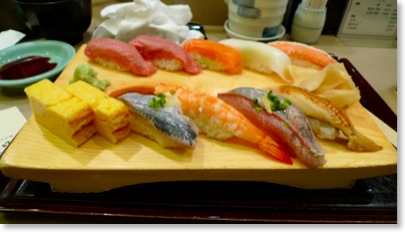Paris food reviews
Although I am here for a hospital appointment I have succumbed to the charms of time spent in this city of eaters!
Moments after alighting from the train I was enjoying the warm crush in the metro as it rumbled towards rambautu .
Just a street away from the Pompidou centre nestles L'Ambassade d'Auvergne and thats exactly what they are.
The menu is drawn from the cooking of the Auvergne. Pate of wild boar with hazelnuts, no doubt something the animal forages for before he ends up on a plate in Paris.
Quite a toothsome pate hugely rustic in it's preparation clad in thick slices of
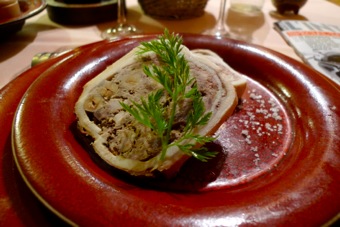
I could not enter this restaurant without having left without eating aligote (mashed potato bound with cantal cheese and garlic so I was immediately drawn to the
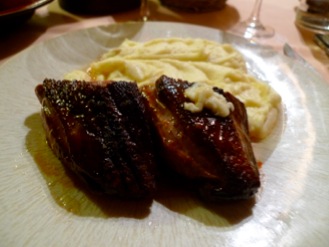
Maiget de. Canard served rare as a preference scythed in two and served with aligote. Much theatre is made of the appearance of the aligote at the table and much stirring and pulling with a wooden spoon demonstrating it's delicious elasticity, finally coming to rest on my plate. If one was to be critical (well ok then) it did have a slightly industrial taste I think brought about that garlic powder was used in the seasoning, which did bring about some confusion after the starter.
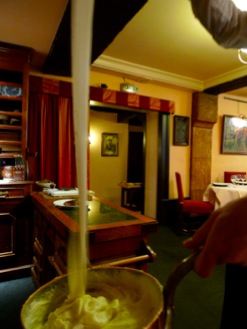
I indulged but only slightly in some wine a St pourcain,
Red and rather good.
No dessert here as in a matter of a few hours another meal would be in front of me.

I had never seen Gaite on the metro map before just perhaps not needing to go there for any particular reason left it out of my periphery.
Well not any longer, recommended by a good friend a surgeon previously based in Paris, who better to understand where to eat the medical profession well known for it's culinary indulgencies.
I'll get to the point, Fish was on the menu this evening and Cagouiile was the place, I had already booked courtesy of my friend, and when I arrived the place was packed Sunday night in Paris few restaurants are open.
The welcome was warm and the menu was presented on a blackboard (whiteboard to be exact) modern times!
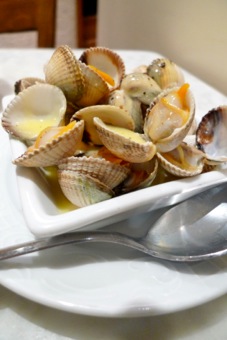
An amuse of freshly steamed open clams drenched in buerre blanc was an inspiration wonderful simple cooking easy to aspire to but few manage it Anchovies I love anchovies and more so ,deep fried heaven.
Auxerros from Alsace 1999, a bargain and delicious to boot, the color of petrol with out the matching tasting notes.
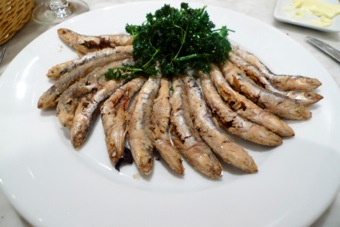
The anchovies arrived suitably fried just dredged in flour and crispy so the whole fish could be eaten, surprisingly served old school with fried curly parsley, ah that brings back culinary memories! I sat there happy as a seal with whole fish being disposed of in a predatory manner the last thing to be seen was the crispy tail disappearing into my mouth.
At this point I have to mention the bread just magical, brown a hint of rye quite possibly wood fired crunchy on the out side with a wonderful open textured inner and with real flavour.
A moment of euphoria, perhaps longer, at least long enough to eat one and a half baskets.
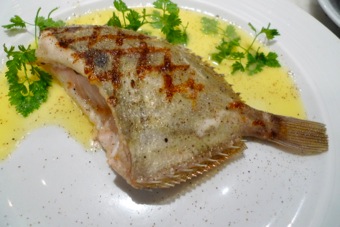
For the main course saint Pierre (john dory) the legend has is that St peter reached into the sea and pulled this ugly little fish from the water and forever laid his mark thumb and forefinger on the fish and the mark is still there.
Well the man sainted as he was had taste in fish because the flesh of this fish is particularly good but does require patience and skill to cook to perfection absolutely no problem here.
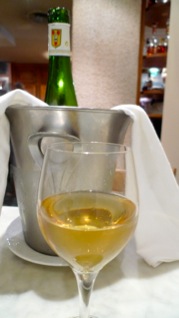
Pudding, well diet and gym time forgotten, pear tart crisp pastry silky pear almond paste perfectly executed.
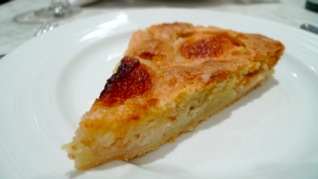
hot cross buns
“Have your cake and eat it”
a trip through regional British cakes
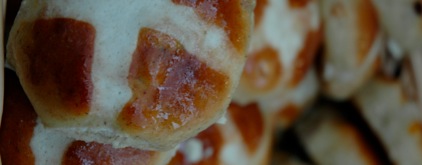
Hot cross buns!
Hot cross buns!
One a penny, two a penny,
Hot cross buns!
If ye have no daughters,
Give them to your sons.
One a penny, two a penny,
Hot cross buns.
The cry of the street vendors as they carried their wares through the streets, a tray of buns perched on their heads.
Easter time has come around again but sadly the street vendors are no longer.
Hot Cross buns have long been a symbol of Good Friday. Today they are sold in bakery shops and supermarket bakeries throughout the Easter season. Each bun has an icing cross on top to signify the crucifixion.
Although this tradition has been going on for centuries the real roots go much further back.
The British history has along association with paganism the cross on the top of the bun would have originally have represented the four quarters of the moon.
Early Christians would have reinterpreted the meaning to signify the crucifixion.
In 1361, a monk named Father Thomas Rockcliffe began a tradition of giving Hot Cross Buns to the poor of St Albans on Good Friday.
In the years that followed, many customs, traditions, superstitions, and claims of rejuvenation, protection from evil and were associated with the buns. In the 16th century, the Roman Church was banned in England, but the popularity of Hot Cross buns continued. Queen Elizabeth I passed a law banning the consumption of Hot Cross Buns except during festivals such as Easter, Christmas and funerals.
Eccles cakes
1793 was a good year for cake making in the town of Eccles.
James Birch began to sell his small flat raisin filled cakes
Starting a culinary legend.
Although traditionally made in the town from where they get their name, Eccles cakes are now known throughout the world. As early as 1818 they were said to be sold "at all the markets and fairs around and were even exported to America and the West Indies".
The word 'Eccles' means church 'Eccles Wakes' took place at the church in Eccles and afterwards there was a fair at which food and drink were sold, including of course, Eccles cakes.
In 1650, when the Oliver Cromwell gained power, they banned the Eccles Wakes and subsequently the Eccles cakes, which they considered to have pagan significance due to their juicy and exotic richness.
St John in London’s Smithfield has always served Eccles cakes with Lancashire cheese a great combination.
Lardy cake
More of a bread than a cake this came about when fruit and spices became available to the British in the 17th century the recipe was developed using a basic bread dough with the fat content being lard rendered from pigs with the addition of sugar spices and dried soft fruits. It was called lardy cake in the West Country, lardy johns in Sussex, dough cake in Buckinghamshire and in Suffolk there was something similar called Fourses Cake.
The cake that isn’t
The Kendal mint cake is not really a cake at all a sweet containing a high amount of sugar and glucose, something that has helped its legend.
Sir Edmund Hillary took the sweet to the top of mount Everest as a good source of energy, available in a small size.
A mistake that went well, according to myth a confectioner was trying to make glacier mints, when his attention wandered, only to discover that the contents of his pan had turned cloudy and grainy, he kept it anyway and upon trying found it to be delicious.
The recipe is credited to Joseph Wiper, who produced the cakes in his shop in the 1800s. His great nephew, Robert Wiper, supplied Kendal Mint Cakes as energy boosters to the 1914-17 Arctic Expedition under the command of Shackleton.
Here in the UK are many regional cakes but many do not travel out of the borders of their County, so the only way to find the new and the old is to travel slowly and enjoy eating cake!
Barcelona
September is a great time to travel to Barcelona warmer than the UK.
Packed with culture and art there is also the fiesta de Merce which runs from the 24 till the 30 September crowd pleasing events such as firework parades with giants in local dress, dragons and loud music.
Running concurrently is a music festival featuring some of the world’s best artists taking place at various venues and squares around Barcelona.
I was there for different reasons, to sample the current hot restaurants and Classic ones too.
Barcelona is so diverse from medieval centre to Olympic village.
The markets are fantastic such great produce always inspiring and segrada famillia the unfinished Gaudi masterpiece is just jaw-dropping.
I stayed in the lower Raval well known for its drug related problems and seedy atmosphere, the council seems to be taking a brave step by bulldozing the worst areas and building public spaces it appears to work, it still can be a little edgy but I rather like that.
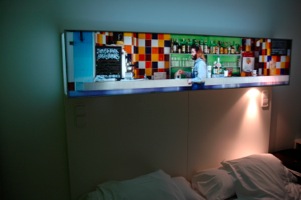
I ate a three different Michelin starred restaurants which were all good, two in particular came out on top Lasarte which started with the signature dish of smoked eel foie gras and caramelized apple terrine and finished with a chocolate filled with praline and salt I can not even begin to explain how good that was and there was only one.
The cram hotel a contemporary hotel in Exaimple contains Can Gaig a Michelin starred restaurant recently relocated from its original building as that was beyond repair. The Gaig family has been chefs for 130 years and Carles is the current incarnation.
Intimate describes well the surroundings of the restaurant deep
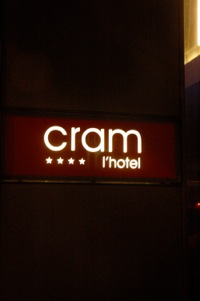
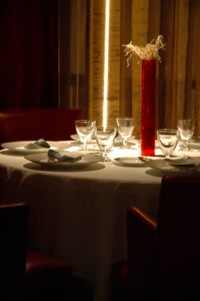
hues of red and subtly lit.
The tasting menu is recommended as it gives a wide selection of the kitchens skills.
Unfortunately one course marred the whole meal a belly of tuna perfectly cooked but salty beyond sense after a mouthful all that could be tasted was salt, it ruined the wine and it took two courses before I regained use my taste buds .
The meal rallied towards the end and redeemed itself.
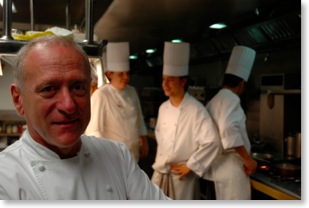
At Abac I ate as one of the 8 courses smoked anchovy with garlic ice cream it almost brought tears to my eyes it was so good it had just been warmed through in the smoker so it was barely cooked just meltingly delicious, paired with a tiny Quenelle of roasted garlic ice cream and a thin wafer of toast just genius.
With Chef Xavier Peliccio at the helm, this restaurant continues to produce involving well thought out beautifully presented dishes, with a nod to old culinary traditions and recipes.
I was overwhelmed by the finesse creativity and flavours presented in his tasting menu I was lucky enough to receive an extra course of roast best end of suckling pig just perfect the cracking thin and crispy like paper.
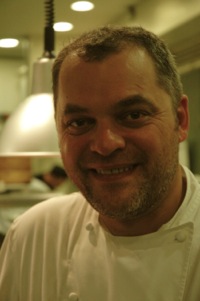
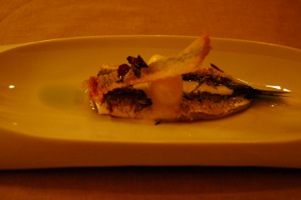
I spoke with Xavier and visited His kitchens and was very pleased to see real stoves with no induction cooking.
I am a great believer in fine cuisine should be produced with heat, passion and hard work there was plenty of that going on in this kitchen.
Lasarte is an outpost of the chef Martín Berasategui The latest star in the firmament of Spanish haute cuisine housed inside the hotel condes a step away from the Pasaig de Gracia a small elongated room greets you along with charming bilingual staff styled in grey nero jackets.
There was great expectancy in regard to the eel and foie terrine I was certainly not disappointed, the smoky oiliness of the eel worked in complete harmony along with the tart freshness of caramelized apple .
Every bite was sad as I became ever closer to finishing the dish.
Restaurants at this level seem to get caught in a trap of over complication style over reasoned thought, the wine list here is a prime example .
A cork box was presented when opened it contained four more cork covered folders each containing a wine list, this was supplemented with a textural swatch evoking the mood of the wines contained within yet all wines were lacking in the needed information grape variety or even a tasting note perhaps!
The meal was peppered with culinary highlights the Ravioli of squid ink translucent pastry holding warm ink and seasoning stock eaten with shredded raw squid and a tumble of rice noodle all popped into your mouth at once to allow the ravioli to burst inside and mingle with the other ingredients was excellent.
A defining moment was with the coffee an inconspicuous chocolate contained a very fine praline and rock salt, which provided a shock to the palate there was a reevaluation of all thing chocolate happening here.
Presentation of the food, namely the finishing of the dishes erred towards twee most courses came with a jus or sauce which was added at the table which for me began to become a little tiring after several courses over complication rears its head again.
Lasarte is worth a trip if you are in Barcelona somewhat easier to reach than the parent restaurant, which is about 15 miles outside of San Sebastian, he also oversees the restaurant at the Guggenheim in Bilbao .
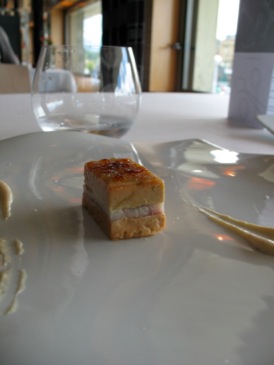
I challenge you to get bored with the food in Barcelona the market called la Boqueria is just awesome such wonderful fresh local products on display and good bars to eat at ,being close to the products makes all the difference octopus for breakfast on morning one pulpo galeggio boiled and drizzled with olive oil and paprika washed down with a glass of chilled cava
next day razor clams ,and the next tripe! Probably the best I have ever eaten.
For the traditionalists among us casa Leopoldo reigns supreme ,Barcelona is still a bullfighting city although the main bullring is being redeveloped, this restaurant is run by a family with a long bullfighting connection ,so of course you can eat oxtail here and being Barcelona there is good fish on offer too.
As my last meal before my return it could not be faulted.
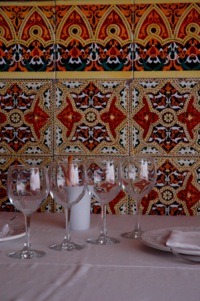
All your shopping needs can be met here in Barcelona also lots of history and culture great wine. But the down side millions of tourists with that come s the pickpockets so one has to be on their guard.
Nonetheless as for dining experiences and they were many a weekend away here has a lot to recommend it, what are you waiting for?
Information follows
Restaurant Lasarte
In the hotel condes
Passeig de Gràcia, 73-75 · 08008 Barcelona Tel. (+34) 93 445 00 00 · Fax: (+34) 93 445 32 32 e-mail: info@condesdebarcelona.com
Can Gaig
C/ ARAGÓ 214 (Aribau Corner)
Telf: 934 291 017
Fax: 934 297 002
info@restaurantgaig.com
Abac
Tues-Sat 1:30-3:30pm; Mon-Sat 8:30-10:30pm
Address
Carrer del Rec 79-89
LocationLa Ribera, Ciutat Vella
Transportation
Metro: Jaume I or Barceloneta
Phone
93-319-66-00
Casa Leopoldo Calle Rafael, 24 Tel 0034 93 441 69 42
japanese writings
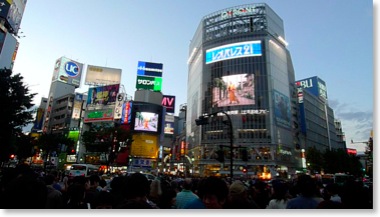
What better place to find yourself on a stopover or longer than the most exciting city in the world: Tokyo, a food lovers dream! There are about 5,000 restaurants in London, 15,000 in New York, but Tokyo boasts 88,000 and still counting. It is a nation obsessed by food, so every type of cuisine can be found here; some of the best Italian dining is to be had in Tokyo, cooked by Japanese chefs. There has been a long history of Japanese chefs working in Michelin restaurants in France and returning to open their own.
Finally Michelin has come to town and sprinkled stars generously and they still have not scratched the surface, there are many that will stay hidden for the private clients where just getting a booking requires an introduction.This is what makes this city special dedication to the culinary art and only sharing with the cognoscenti.
Believe me there is plenty of choice without needing a bottomless wallet and a network of those in the know!
The French and British super chefs are making inroads into Tokyo. Robluchon has his second Artelier here, Pierre Gagnaire has opened recently, Gordon Ramsey has made a showing with two restaurants at the Conrad hotel and Alain Ducasse with Beige is receiving its first plaudits .
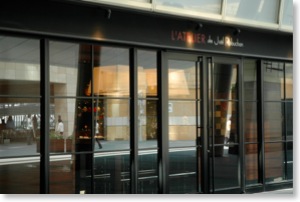
Here can be found hotels in abundance from capsule to the highest in luxury; service is exemplary and tipping is definitely frowned upon.
A subway system that is efficient, clean and vast; Shinjuku station moves over 2 million people a day. It is quite interesting to be listening to music on you iPod, something serene. Just find a spot and watch the mass of rushing humanity, quite an ethereal experience.
Accommodation
Tokyo, known for the stratospheric price of its real estate, deals with it the same way as New York; they build high, and as for hotel rooms they tend to be smaller than their European counterparts. Nonetheless accommodation can be reasonable. You could stay close to the Ginza and within walking distance of Tsukiji market for about ¥8,000 in a business hotel, not big on glamour but more than adequate; perhaps a family run ryokan in the old part of town near Asakusa Kannon temple, with a roof top ofuro (bath) with views over the roofs and temples of Tokyo .
If you would like to relive moments of ‘lost in translation’, the Park Hyatt would be your destination, late at night with a scotch, sat at the bar overlooking the sea of neon.
The love hotels of Tokyo for those who like a room with a difference. To explain: the Japanese live in close proximity to each other, many living with their parents or they are just dating and there is nowhere for privacy, so you can rent a room by the hour, some with wild themes: spacecraft, funfairs, vibrating beds, jacuzzis. These are seldom used overnight, so turning up late and getting a cheap room is always possible.
And finally something so Japanese: the capsule hotel, cheap but not for the claustrophobic, they have a communal washing facility much like an onsen, but these hotels are single sex generally and are geared to the salary man who is usually too drunk or too late to get home after a night out with his fellow workers.
Places to see
Kannon temple in Asakusa, one of the most visited in the city, boasts an avenue of shops leading down to the temple, preceded by an enormous red lantern. This area is what is called ’shitamachi’ or the area under the castle. This would have been where the trades people of old Tokyo would have lived and worked close by the castle, producing goods and services for those that could afford them. It still retains its charm and some old buildings. There is even an old 1950s funfair open everyday; nostalgia in a city where it is disappearing fast.
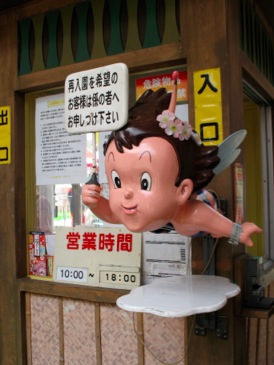
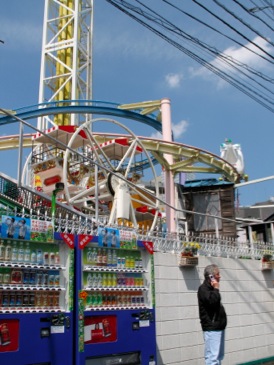 
Kappabashi, a short walk from
Tawaramachi on the Toei Ginza line, is a street lined with catering equipment shops. You can buy anything from handmade knives to custom noren, a sushi chef’s jacket or plastic food.
From the local pier you can take a spacecraft-like ferry that will take you down the river to Odaiba, the reclaimed island in Tokyo harbour. A smaller version of the statue of liberty awaits, along with modernist buildings, notably Fuji TV with its Van der Graaf generator-style viewing tower. Here you will also find themed bars, restaurants and gift shops for the manga generation, and Tokyo Big Sight, a conference and exhibition hall hosting many events all year round.
Yurikamome, the elevated train, leaves here back into the city over the rainbow bridge. Lit up at night, this bridge takes road traffic and trains on different levels and deposits you at Shimbashi station, where just behind, is the holy grail for those with a sweet tooth, Ogawaken, a Japanese patisserie baking in the French style, famous for their ‘raisinwich’, a buttery almond topped biscuit sandwich filled with air light buttercream and enormous raisins steeped in rum, about £5.00 a box, so popular that they sometimes run out. They also have a tea/coffee shop and you can enjoy their cakes here too.
Perhaps something more substantial for lunch, located in the same building, is a soba shop: home made soba and a good selection of sake, all of the best standard and freshness.
Art
The Japanese have a tradition going back centuries of the finest crafts and artworks, something that continues to this day. It can be seen for free in the specialist shops featuring wedding kimono of the very finest hand woven cloth. If you look hard, some quite extraordinary contemporary designs are available, but not for sale to the casual tourist, as they can cost into the millions of yen.
The same can be said of pottery, an ancient art originally imported from Korea and changed over the centuries to the Japanese way. There are mountains of ceramics, art pieces and tableware available cheaply and of great quality; a wonderful but heavy gift, if you get carried away.
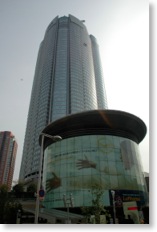
Modern art lives and flourishes here and one of the best places, a day out on its own, is the Mori art museum on the 53 rd floor of the Mori building in Roppongi Hills, with an English curator. It is the jewel in the crown. Always there seem to be great exhibitions on here and so much more. There is a viewing platform with 360º views of Tokyo day and night,
Art on the streets is brought by the younger generation in fashion form. What you see here filters down to Europe in some form or another. The Japanese can be extreme with their fashion; the only time in their lives when rebellion is OK, before filtering back into the homogeneous society .
Eating
All tastes are catered for here and the standards are high. There are food floors in the department stores; whole city blocks given over to a myriad of small specialist retailers from chocolate to chanko nabe, the sumo wrestlers’ dish.
The finest products from all over the world, Château Lafite jostling for position with the finest sake, Scottish wild smoked salmon or the melt in the mouth Toro fatty tuna.
It all harks back to the past; the cries of the shop assistants ring out over the marble halls decked with chandeliers all trying to get your custom. Apart from the environment nothing has changed over time. People eat here as it’s the national pastime; beer not sake is the beverage of choice, well represented by Asahi Kirin and many others .
If your first taste of sushi was a supermarket package of over chilled densely packed rice topped with a sliver of not so fresh fish underpinned by fiery virulent green wasabi, you are in for a major shock. It’s not like that at all. Kaiten sushi going round on a belt can be excellent, but owing to the price you will still get the powdered wasabi which is in fact colored horseradish and bears only a passing resemblance to the real thing, which is somewhat more subtle and refined; the fish will be a little thinner than bespoke sushi but very good value.
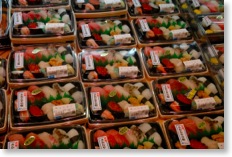
The real deal seldom comes cheap, but it is an experience you will savour forever. After waiting for your seat, finally you get a place at the counter, sushi chefs busy themselves with the constant flow of orders from the seated diners, placing perfectly crafted pieces of rice and fish directly onto to a lacquered surface, piling beside home made pickled ginger, originally there as an aid against bacteria, along with the vinegared rice. Initially used as a preservative, this would be stuffed into fish to help its preservation.
The rice is at room temperature, topped with your chosen fish or shellfish, which has been smeared on the underside with hand grated wasabi. The topping is cold, but not too chilled, allowing all the delicate flavours and textures to be at their best. This is dipped into shoyu (soy sauce) much more delicate and refined than what we generally find in the UK. Some sushi shops will soften the sauce with dashi (kelp and bonito stock) or paint the fish ready for eating and not offer shoyu.
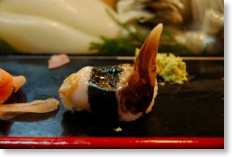
It is not always necessary to use chopsticks; using ones hands is quite acceptable. You will have been presented with a hot towel at the beginning of the meal or in the summer a chilled one; just wipe your hands on this.
The variety of fish and shellfish is enormous and seasonal, variation in price is usually upwards although some bargains are to be had if you like oily fish. Iwashi or sardine is fantastic. Small and bright, it is filleted and the membrane is removed leaving a silvery surface. It is topped with finely grated ginger and shredded negi (spring onion).
The undisputed favourite of the Japanese is Toro, the fatty belly of tuna, meltingly delicious. There is nothing to compare and it should be tried at least once at source in a lifetime.
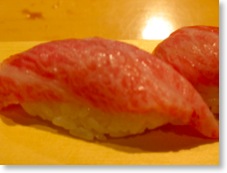
Where to find the best
Tsukiji market from 5am. Expect queues at the weekend. My favorite and now, it seems, everybody else’s is Daiwa (? Yamato?) identified by its brown on white noren and big queues. I have tried them all and this still reigns supreme; the best in Tsukiji, the best in the world…?
Sushi Bun still excellent, not so busy but well established. The adjacent streets feature a large market, labyrinth in style, featuring many sushi shops, including a 24 hour establishment, so if you are only here briefly there is no excuse not to indulge. Even when leaving Tokyo, the airport comes up trumps with a sushi shop which is excellent and reasonable; an oasis of calm in a busy airport.
